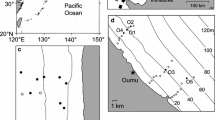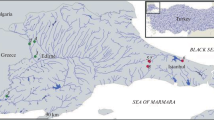Synopsis
Spatial distribution and feeding habits of the puffer fish,Takifugu niphobles, were studied to understand its mode of resource utilization in an intertidal sand flat at Tomioka in the western coast of Kyushu Island, Japan. The transect survey during high tides showed the presence of young puffers near the shoreline, while adults were mainly found in the offshore area of the sand flat. The gut contents analysis showed that although the young puffers foraged more frequently on organisms dwelling in the inshore area than the adults, both puffers fed mainly on the ghost shrimpCallianassa japonica inhabiting the entire sand flat. There was no apparent difference in the size of consumedC. japonica between the young and adult puffers. However, comparison of size structures of ghost shrimps in the field and in the gut contents showed that the young puffers foraged both from inshore and offshore areas of the sand flat, while the adults foraged mainly in the offshore area. This suggests that young puffers move more frequently over the sand flat with tides than adult ones. This pattern of trophic separation among size classes may reflect environmental features of the intertidal sand flat with large tidal fluctuations.
Similar content being viewed by others
References cited
Desselle, W.J., M.A. Poirrier, J.S. Rogers & R.C. Cashner, 1978. A discriminant function analysis of sunfish (Lepomis) food habits and feeding niche segregation in the Lake Pontchartrain, Louisiana Estuary. Trans. Amer. Fish. Soc. 107: 713–719.
De Silva, S.S., 1973. Abundance, structure, growth and origin of inshore clupeid populations of the west coast of Scotland. J. Exp. Mar. Biol. Ecol. 12: 119–147.
Gordon, J.D.M., 1977. The fish populations in inshore waters of the west coast of Scotland. The distribution, abundance and growth of the whiting (Merlangius merlangius L.). J. Fish Biol. 10: 587–596.
Helfman, G.S., 1978. Patterns of community structure in fishes: summary and overview. Env. Biol. Fish. 3: 129–148.
Katayama, M., S. Fujita & Y. Fujioka, 1966. Ecological studies on the puffer,Fugu niphobles (Jordan et Snyder). II. On the habit of burrowing into the bottom sand. Bull. Fac. Educ. Yamaguchi Univ. 15: 77–84 (in Japanese).
Keast, A., 1978. Trophic and spatial interrelationships between the year classes in the fish species of an Ontario temperature lake. Env. Biol. Fish. 3: 7–31.
Livingston, R.J., 1982. Trophic organization of fishes in a coastal seagrass system. Mar. Ecol. Prog. Ser. 7: 1–12.
MacPherson, E., 1981. Resource partitioning in a Mediterranean demersal fish community. Mar. Ecol. Prog. Ser. 4: 183–193.
Masuda, H., K. Amaoka, C. Araga, T. Uyeno & T. Yoshino, 1984. The fishes of the Japanese Archipelago. Tokai University Press, Tokyo. 456 pp.
Miyamoto, S., 1982. Feeding ecology of the puffer,Fugu niphobles in the sand flat. Master's Thesis, Kyushu University, Fukuoka. 63 pp.
Nojima, S., Y. Kitajima, Y. Kuwahara, S. Miyamoto & S. Furunishi, 1980. Preliminary report on a food web in a tidal sand flat, with special reference to a subweb centering around a sand snail,Umbonium (Suchium) moniliferum. Benthos Res. 19/20: 71–80 (in Japanese).
Potter, L.C., A.J. Cheal & N.R. Loneragan, 1988. Protracted estuarine phase in the life cycle of the marine pufferfishTorqigener pleurogramma. Mar. Biol. 98: 317–329.
Ross, S.T., 1986. Resource partitioning in fish assemblages: a review of field studies. Copeia 1986: 352–388.
Schoener, T.W., 1974. Resource partitioning in ecological communities. Science 185: 27–39.
Sokal, R.R. & F.J. Rohlf, 1969. Biometry. W.H. Freeman & Company, San Francisco. 776 pp.
Tamaki, A., 1988. Effects of the bioturbating activity of the ghost shrimpCallianassa japonica Ortmann on the migration of a mobile polychaete. J. Exp. Mar. Biol. Ecol. 120: 81–95.
Tamaki, A. & K. Suzukawa, 1991. Co-occurrence of the cirolanid isopodEurydice nipponica Bruce & Jones and the ghostshrimpCallianassa japonica Ortmann on an intertidal sand flat. Ecol. Res. 6: 87–100.
Tamaki, A., S. Miyamoto, T. Yamazaki & S. Nojima, 1992. Abundance pattern of the ghost shrimpCallianassa japonica Ortmann (Thalassinidea) and the snake eelPisodonophis cancrivorus (Richardson) (Pisces: Ophichthidae) and their possible interaction on an intertidal sand flat. Benthos Res. 43: 11–22.
Yamahira, K., 1994. Combined effects of tidal and diurnal cycles on spawning of the puffer,Takifugu niphobles (Tetraodontidae). Env. Biol. Fish. 40: 255–261.
Yamamoto, G. & T. Ito, 1973. Aquatic animal ecology I. Kyoritsu Publications, Tokyo. 95 pp. (in Japanese).
Author information
Authors and Affiliations
Rights and permissions
About this article
Cite this article
Yamahira, K., Kikuchi, T. & Nojima, S. Age specific food utilization and spatial distribution of the puffer,Takifugu niphobles, over an intertidal sand flat. Environ Biol Fish 45, 311–318 (1996). https://doi.org/10.1007/BF00003100
Received:
Accepted:
Issue Date:
DOI: https://doi.org/10.1007/BF00003100




